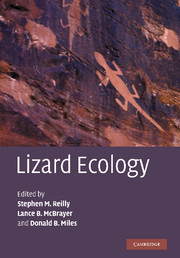Preface
Published online by Cambridge University Press: 04 August 2010
Summary
Investigations into the natural history of lizards have been a major source of discovery in many disciplines of biology, including, but not limited to, morphology, physiology, ecology, and evolution. Although lizards serve as model organisms for a variety of research topics, the group has figured prominently in ecological studies. In particular, the 1960s witnessed a proliferation of theoretical and quantitative studies in population and community ecology that were based on data collected from lizards. As a survey of papers from the past 40 years will attest, squamate reptiles continue to serve as key organisms in ecological research. The evolution and ecology of feeding behavior is one area of ecology in which conclusions emerging from studies based on lizards were most influential. Two early papers are especially relevant to the study of feeding ecology in lizards. The study of community structure and habitat use of North American desert lizards by Pianka (1966) was one of the first to suggest a classification of species into either sit-and-wait or “constantly moving” in an attempt to link resource exploitation, habitat structure and species diversity. A few years later, Schoener (1969a, b, 1971) presented models of optimal predator size based in part on “idealized” lizard predators that corresponded to “sit-and-wait” and “widely foraging” species.
Subsequently, Huey and Pianka (1981) considered the question of which ecological traits were potentially affected by differences in foraging mode.
- Type
- Chapter
- Information
- Lizard Ecology , pp. xi - xivPublisher: Cambridge University PressPrint publication year: 2007



